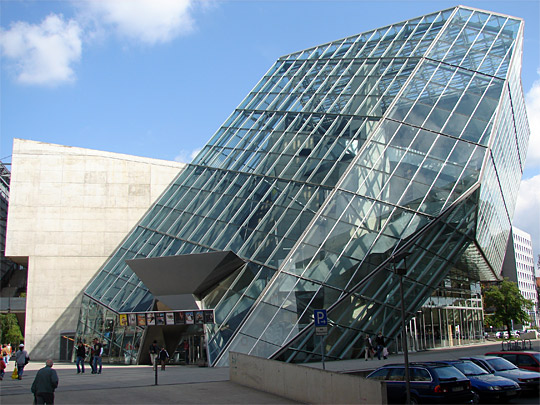Deconstructivism
Deconstructivism is a Postmodern architectural style characterised by the idea of fragmentation and the manipulation of a structure’s surface. Buildings adopting the style are often formed of components that have been disassembled and reassembled in a new and unorthodox way, giving the impression of a chaotic design devoid of precise logic.
It attempts to move away from the conventions of modernism that can be viewed as ‘constricting rules’, such as the notions that ‘form follows function’, ‘purity of form’, and ‘truth to materials’.
Deconstructivism in architecture was influenced by the deconstructivist theories of the French philosopher Jacques Derrida, who said that ‘architecture is nothing but one of many ways of communication’. It was also influenced by early-20th century constructivist architecture developed in Soviet Russia.
Deconstructivism developed out of the postmodern style and first gained widespread attention in 1988 with an exhibition entitled ‘Deconstructivist Architecture’ in New York’s Museum of Modern Art. The exhibition featured the work of architects such as Frank Gehry, Rem Koolhaas and Zaha Hadid. Where deconstructivism deviates from the postmodernist style in its rejection of ornament as decoration.
Other defining stylistic features include:
- Unrelated forms.
- Abstract nature.
- Smooth exterior surfaces.
- Contrast of shapes and forms.
- Large expanses of a single material (glass, metals, masonry, etc.).
- Window frames often hidden in the walls.
- Simple metal frame doors.
- Exposed materials.
The rise in prominence of computer-aided design (CAD) in contemporary architecture was a key factor in the development of deconstructivism, as three-dimensional modeling enabled the intricate design of complicated and unorthodox shapes and spaces.
Despite seeking to distance himself from the label, one of the most prominent architects associated with the style is Frank Gehry, whose Santa Monica residence – the building for which he first received critical acclaim – is regarded as the prototypical deconstructivist building, as well as his later buildings the Guggenheim Museum and Walt Disney Concert Hall.
Other architects who have been identified with the style are Zaha Hadid, Peter Eisenman, Rem Koolhaas, and Daniel Libeskind.
The most notable examples of deconstructivism are:
- CCTV Headquarters, Beijing.
- Dancing House, Prague.
- Imperial War Museum, Manchester.
- Guggenheim Museum, Bilbao.
- Jewish Museum, Berlin.
- Walt Disney Concert Hall, Los Angeles.
[edit] Related articles on Designing Buildings Wiki
- Architectural styles.
- Art Deco.
- Art Moderne.
- Art Nouveau.
- Bauhaus.
- BEST Products showrooms.
- Blobitecture.
- Brutalism.
- Chinese brutalism.
- Computer aided design (CAD).
- Concept architectural design.
- Constructivist architecture.
- Dancing House, Prague.
- Frank Gehry.
- Guggenheim Museum, Bilbao.
- High-tech architecture.
- Italian brutalism.
- Metabolism.
- Peter Eisenman.
- Parametricism.
- Postmodern architecture.
- Spomeniks.
- Walt Disney Concert Hall.
- Zaha Hadid.
[edit] External references
Featured articles and news
ECA progress on Welsh Recharging Electrical Skills Charter
Working hard to make progress on the ‘asks’ of the Recharging Electrical Skills Charter at the Senedd in Wales.
A brief history from 1890s to 2020s.
CIOB and CORBON combine forces
To elevate professional standards in Nigeria’s construction industry.
Amendment to the GB Energy Bill welcomed by ECA
Move prevents nationally-owned energy company from investing in solar panels produced by modern slavery.
Gregor Harvie argues that AI is state-sanctioned theft of IP.
Heat pumps, vehicle chargers and heating appliances must be sold with smart functionality.
Experimental AI housing target help for councils
Experimental AI could help councils meet housing targets by digitising records.
New-style degrees set for reformed ARB accreditation
Following the ARB Tomorrow's Architects competency outcomes for Architects.
BSRIA Occupant Wellbeing survey BOW
Occupant satisfaction and wellbeing tool inc. physical environment, indoor facilities, functionality and accessibility.
Preserving, waterproofing and decorating buildings.
Many resources for visitors aswell as new features for members.
Using technology to empower communities
The Community data platform; capturing the DNA of a place and fostering participation, for better design.
Heat pump and wind turbine sound calculations for PDRs
MCS publish updated sound calculation standards for permitted development installations.
Homes England creates largest housing-led site in the North
Successful, 34 hectare land acquisition with the residential allocation now completed.
Scottish apprenticeship training proposals
General support although better accountability and transparency is sought.
The history of building regulations
A story of belated action in response to crisis.
Moisture, fire safety and emerging trends in living walls
How wet is your wall?
Current policy explained and newly published consultation by the UK and Welsh Governments.
British architecture 1919–39. Book review.
Conservation of listed prefabs in Moseley.
Energy industry calls for urgent reform.




























